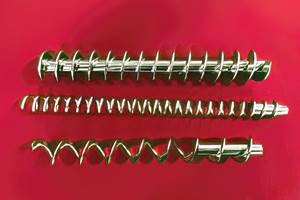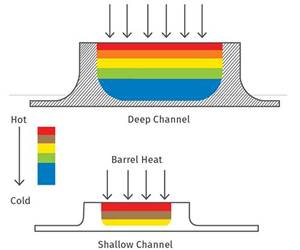Share
Read Next

Vibration affects all machines that move, including robots. Ulendo is a startup that launched with a vibration compensation algorithm for fused filament fabrication (FFF) 3D printers and is now working to apply it to robots. Source: Ulendo
Any machine that moves deals with vibration, whether it’s a 3D printer, machine tool or robot. It’s typically managed to the point that many do not even realize that vibration is a problem, but with proper strategies to deal with vibration, machines can run faster and more efficiently.
Ulendo is an Ann Arbor, Michigan-based startup that produces software solutions for manufacturing automation. The company launched with a product that’s now called (for “vibration compensation”). This VC applies an algorithm to fused filament fabrication (FFF) 3D printers that counteracts the machine’s vibration patterns, enabling it to run up to five times faster while maintaining part quality.
Since the launch of Ulendo VC, the company has expanded into laser powder bed fusion (LPBF) additive manufacturing with Ulendo HC (heat compensation), which optimizes the path of an LPBF machine’s laser to reduce heat-induced deformation and stress. It’s also offering Ulendo Calibration-as-a-Service, which applies its vibration compensation to end-users’ extrusion 3D printers (as opposed to working with machine suppliers, as is the case with Ulendo VC). The company is also broadening its reach to include machines outside the 3D printing space with its fourth product: vibration compensation for robots.
Early research on VC for robots has focused on various applications for robotic arms, as well as three-axis gantry robots for machine tending. But Ulendo founder and University of Michigan mechanical engineering professor Chinedum Okwudire says he believes the underlying problems and solutions also apply to other applications, including three-axis cartesian robots used in injection molding.

Founder Chinedum Okwudire describes one application involving cameras mounted on robot arms for inspection. The cameras vibrated when the robots stopped moving and had to wait 30 times longer than it took to move the robot into position to stop vibrating enough to take a clear image. Source: Ulendo.
Not-So-Good Vibrations
Vibration affects robots in much the same way as 3D printers. “It's the same problem showing up in different ways for different applications,” Okwudire explains. He describes one use case where an automotive manufacturer was using robots mounted with cameras to complete visual inspection tasks. When the robots moved into position and stopped, the robots — and therefore the cameras — continued to vibrate.
“You can't take the image while the camera is vibrating, because you get a blurry image, so they’d have to wait for the camera to stop vibrating,” he explains. This resulted in much longer cycle times. He says the camera took 30 times longer to stop vibrating enough to take a photo than it took for the robot to move the camera into position. Longer cycle times can mean significant losses in productivity. Okwudire points out that as development and adoption of AI increases, so will demand for applications such as these.
Vibration can also damage delicate parts, as in the case of electronics assembly applications. The silicon wafers used in semiconductors are fragile, so any vibrations that occur as a robot places a wafer into a cassette could damage the wafer. “They have to go very slowly to avoid that,” Okwudire says.
Moving the robot slower is the most common vibration mitigation strategy. Adding friction to damp vibration is another option, though this causes additional wear and tear on the robot and increases energy needs. Reducing payload is another common method to reduce vibration in robotics. In fact, Okwudire says experts often recommend robots and cobots carry payloads that are half the weight of the listed maximum payload to reduce vibration. This “is a big issue for robotics where payload really matters,” he notes.

Ulendo’s VC algorithm works by creating a “calibration map” that predicts how the machine will vibrate, and then adjusting its movement to offset the vibration. (So, if the machine veers to the right, VC adjusts its motion to the left and the machine will go straight). However, applying VC to robots is more complicated than 3D printers because a robot’s calibration map will change based on its payload and position.
Vibration Compensation
Ulendo’s solution actually compensates for a machine’s vibrations instead of working around them. It does this by “tricking the machine,” as Okwudire describes it. Traditionally, Ulendo measures the machine’s vibration patterns and creates a “calibration map” that predicts how the machine will vibrate and calculates how to offset that motion. So, if a machine veers to the left instead of going straight, Ulendo VC-R (vibration compensation for robots) adjusts the path to the right, which cancels out the leftward motion and causes the machine to go straight.
However, Okwudire notes that robots are a much more complex application for the underlying vibration compensation algorithm than 3D printers. Extrusion 3D printers have a constant payload (the printer nozzle) and limited motion (usually three axes). Robots, on the other hand, can have varying payloads and many more axes of motion. The robot’s vibration patterns change based on its position and what it’s holding, making vibration more difficult to predict and compensate. However, some robotics applications involve payloads that don’t change, as in the cases of the robots with the camera and silicon wafers. Given that the vibration will only vary based on the robot’s position, these applications are good starting points for Ulendo VC-R.
For situations where the payload changes between jobs, as in the case of a machine-tending robot that’s switching from one part to another, Okwudire says vibration compensation would function much like the calibration-as-a-service product it offers for 3D printers — the robot would recalibrate the vibration map between tasks.
In the most complex scenario, the payload is constantly changing throughout the course of the job, such as pick-and-place tasks with an assortment of objects. Okwudire says artificial intelligence (AI) or machine learning approaches could make this possible, but adds that this would be further in the future.
Okwudire acknowledges that other software products in the robotics space are designed to handle vibration compensation in repeating tasks. He notes that these products are only suitable for robots that perform the same motion repeatedly. Any deviation from the motion or task for which they were calibrated would require the robots to be recalibrated. Ulendo aims to set itself apart by creating a solution that doesn’t need robots to be calibrated for each new motion or task.

Vibration compensation could make lower cost robots and collaborative robots safer and more efficient, making automation more available to a wider range of manufacturers.
Democratizing Robots
Vibration compensation would enable robots to move faster and handle heavier payloads without changing the robot’s hardware, meaning they could handle more tasks. This is especially true for collaborative robots (cobots), which have extra compliance in their joints. This makes them safer, but also increases vibration, sometimes to the point that these robots are unusable. Okwudire describes one 3D printer manufacturer that purchased a cobot to aid in production of its 3D printers. The cobot wasn’t precise enough for production, so it was relegated to serving beer to employees. Vibration compensation can ensure these cobots are both safe and efficient.
As with 3D printers, vibration compensation can make lower cost robots and cobots more powerful in terms of speeds and payloads. Okwudire says Ulendo is working with a company that’s developing a low-cost robot in the $10-15,000 range for small and medium-sized manufacturers. Vibration compensation software will be key in ensuring the robot is safe, low-cost and precise, and will help “democratize robots in manufacturing,” he says.
A calibration-as-a-service model will also enable manufacturers to get more use out of the robots they already have. “There are robots in the field already that have been used for a couple of years, and we can breathe new life into them,” says CEO Brenda Jones. “That means manufacturers who have made a big investment in these robots, when they need to expand capacity, instead of buying new robots, they can just increase the throughput or the capabilities of their existing investments.”
About the Author
Julia Hider is a senior editor for , where she writes about the metalworking industry. She also serves as the robotics and autonomy correspondent for parent company . To find more of her content, .
Related Content
What to Know About Your Materials When Choosing a Feeder
Feeder performance is crucial to operating extrusion and compounding lines. And consistent, reliable feeding depends in large part on selecting a feeder compatible with the materials and additives you intend to process. Follow these tips to analyze your feeder requirements.
Read MoreThe Importance of Barrel Heat and Melt Temperature
Barrel temperature may impact melting in the case of very small extruders running very slowly. Otherwise, melting is mainly the result of shear heating of the polymer.
Read MoreHow to Select the Right Cooling Stack for Sheet
First, remember there is no universal cooling-roll stack. And be sure to take into account the specific heat of the polymer you are processing.
Read MoreWhy Are There No 'Universal' Screws for All Polymers?
There’s a simple answer: Because all plastics are not the same.
Read MoreRead Next
At Mill 19, the site of the Advanced Robotics for Manufacturing Institute and Carnegie Mellon University’s Manufacturing Futures Institute, robotics data provides the foundation for AI and digital twins.
In this episode of the AM Radio podcast, Robots & Autonomy Editor Julia Hider joins Additive Manufacturing’s Executive Editor Stephanie Hendrixson and Editor-in-Chief Peter Zelinski to discuss how robots and 3D printing enable each other.
At Carnegie Mellon University’s Manufacturing Futures Institute, researchers use a robotic test bed where AMRs deliver Lego bricks to robot arms for assembly to study AI, multirobot collaboration, assembly, safety and more.










